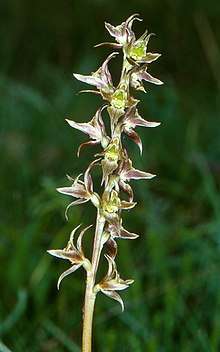Prasophyllum wilkinsoniorum
Prasophyllum wilkinsoniorum is a species of orchid endemic to New South Wales. It has a single tubular, bright green leaf and up to forty five scented, dark greenish-brown to brownish-red flowers with a green to pinkish labellum. It grows in grassy places in a restricted area on the Southern Tablelands.
| Prasophyllum wilkinsoniorum | |
|---|---|
 | |
| Prasophyllum wilkinsoniorum growing near Bombala | |
| Scientific classification | |
| Kingdom: | Plantae |
| Clade: | Tracheophytes |
| Clade: | Angiosperms |
| Clade: | Monocots |
| Order: | Asparagales |
| Family: | Orchidaceae |
| Subfamily: | Orchidoideae |
| Tribe: | Diurideae |
| Subtribe: | Prasophyllinae |
| Genus: | Prasophyllum |
| Species: | P. wilkinsoniorum |
| Binomial name | |
| Prasophyllum wilkinsoniorum | |
Description
Prasophyllum wilkinsoniorum is a terrestrial, perennial, deciduous, herb with an underground tuber and a single bright green, tube-shaped leaf, 300–400 mm (10–20 in) long with a white to reddish base. Between fifteen and forty five flowers are arranged along a flowering spike up to 450 mm (20 in) high. The flowers are dark greenish-brown to brownish-red and scented. As with others in the genus, the flowers are inverted so that the labellum is above the column rather than below it. The dorsal sepal is egg-shaped to lance-shaped, 8–11 mm (0.3–0.4 in) long, about 4 mm (0.2 in) wide and turned downwards. The lateral sepals are linear to lance-shaped, 8–11 mm (0.3–0.4 in) long, about 2 mm (0.08 in) wide and the petals are linear to narrow lance-shaped, 8–12 mm (0.3–0.5 in) long and about 2 mm (0.08 in) wide. The labellum is green to pinkish, broadly egg-shaped to lance-shaped, 7–9 mm (0.3–0.4 in) long, about 5 mm (0.2 in) wide and turns sharply upwards with wavy edges. There is a fleshy green to brown callus in the centre of the labellum. Flowering occurs from December to January.[2]
Taxonomy and naming
Prasophyllum wilkinsoniorum was first formally described in 2000 by David Jones from a specimen collected near Tantawangalo and the description was published in The Orchadian.[1]
Distribution and habitat
This leek orchid grows between Cathcart and Tantawangalo, usually in grassy flat areas.[2]
References
- "Prasophyllum wilkinsoniorum". APNI. Retrieved 29 October 2017.
- Weston, Peter. "Prasophyllum wilkinsoniorum". Royal Botanic Garden Sydney - plantnet. Retrieved 29 October 2017.
External links

